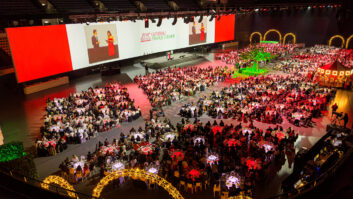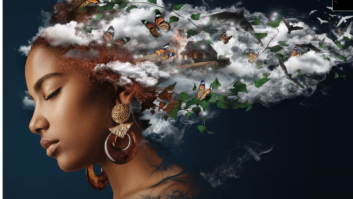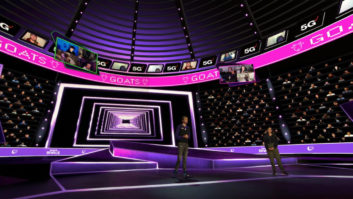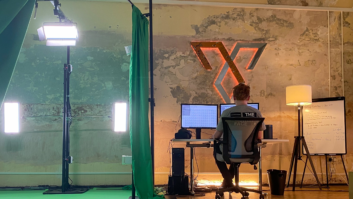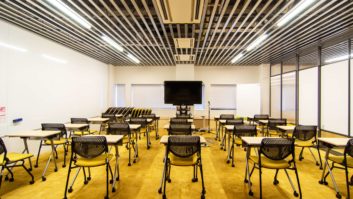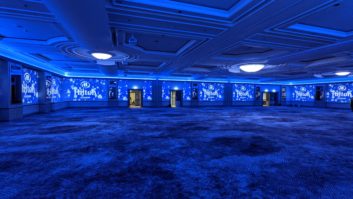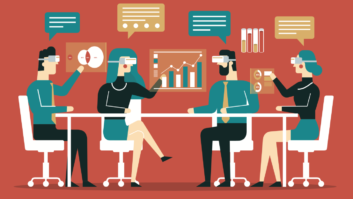Once associated with photography rather than video meetings, the word zoom has been given fresh meaning by the pandemic. The online communication platform has, along with the likes of Teams and Google Meet, enabled people to stay connected in ways not really deemed that vital before coronavirus came along.
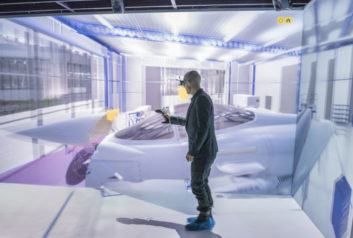 But as good as Zoom is at allowing online gatherings, it is far from perfect. Users complain of social pressures, tiredness and technological issues. Upping the ante, some enterprising companies have taken to using virtual reality (VR) for meetings, where all participants wear VR headsets and can see each other in 3D. Before the pandemic, VR had already begun to make a name for itself as a cutting-edge training tool and entertainment medium, but now it is showing signs of emerging into the communications spotlight.
But as good as Zoom is at allowing online gatherings, it is far from perfect. Users complain of social pressures, tiredness and technological issues. Upping the ante, some enterprising companies have taken to using virtual reality (VR) for meetings, where all participants wear VR headsets and can see each other in 3D. Before the pandemic, VR had already begun to make a name for itself as a cutting-edge training tool and entertainment medium, but now it is showing signs of emerging into the communications spotlight.
One company using VR rather than Zoom for meetings is London-based Visualise, which itself specialises in creating extended reality (XR) content for clients including Mercedes-Benz and BT Sport.
“Wearing VR headsets you can chat away, which is cool but it’s still no replacement for the real thing, says co-founder Henry Stuart. He feels that VR is better than Zoom, but when wearing a headset you cannot jot notes down (in the real world) as you are trapped in the virtual world and are unable to see the pen and paper in front of you. For Stewart, collaborative VR tools are better than not being connected, but they are not better than real-life.
Themed VR
VR requires careful implementation, according to Simon Reveley, CEO, of Guildford-based Figment Productions. His company has designed and built VR rides at theme parks including Derren Brown’s Ghost Train at Thorpe Park. “There are 175 VR headsets on three moving train carriages. It’s one of the most ambitious public VR experiences on the planet, delivering thousands of guests per day,” he says. “That kind of ambition presents a real challenge in a high-throughput ride environment. VR demands a lot from the operations team who have to commit to maintain, clean and prepare the equipment.”
One of the challenges of VR is that, according to Reveley, anecdotal evidence suggests it can take two-four minutes for users to get over the novelty of being in virtual reality before they can focus on the content itself. This presents a challenge for theme parks, where rides are sometimes less than two minutes long, although the Ghost Train experience lasts over 12 minutes.
Reveley feels the tech works better as a second-gate experience, such as in a museum where there is less pressure time-wise and financially on the VR part of the attraction. Even better though, is a dedicated, high-end venue where people go for the VR experience, particularly a shared one and also not one where VR is a part of something else. This ensures staff are trained properly and customer expectations are allied solely to VR.
Dome projection
Dome projection shows, which have been around since planetariums were first built more than three centuries ago, now seem to fall under the umbrella of VR. Reveley says that the experience is comparable in that wherever you look you see a virtual world created around you. Figment has designed and built such a show at Silverstone, where people sit in cinema style seats but are transported by an immersive show to the pits and onto a white-knuckle drive round the circuit, aided by overhead visuals and sound effects.
“The popularity of VR has given dome shows a new lease of life,” Reveley says, “because they give people a very similar experience.” The Silverstone dome uses several projectors but Reveley says the number of projectors used is irrelevant – “You can do it with one or you can do it with 20.”
Visualise’s Stuart says that the pandemic triggered a surge of interest from the enterprise sector looking to use VR, not just for meetings but also as a training tool, and from travel companies offering customers an online taste of destinations.
As well as VR, Visualise has seen a lot of interest in augmented reality (AR), especially from retailers looking to let people see how a product would look in their home. Of course, unlike VR, AR doesn’t require a headset such as the Oculus Quest or HTC Vive Cosmos, and can be used by anyone with a smartphone or tablet.
The company recently created some AR features for the new BT Sport app, which has many extra augmented features including stats and data that be overlaid onto the screen. “You can have the same view as a pundit or presenter on TV with a virtual stadium appearing in front of you on a coffee table and can see live stats coming through,” Stuart says.
3D scans
The next stage for the technology will be live volumetric 3D scans of an entire match that will allow someone (with a headset) to feel like they are on the pitch among the players. Stuart: “You could literally stand on the pitch next to the goalkeeper while a penalty is being taken during the World Cup final. That’s not Star Trek stuff, it’s realistic. We know how to do it, it’s just a question of processing power.”
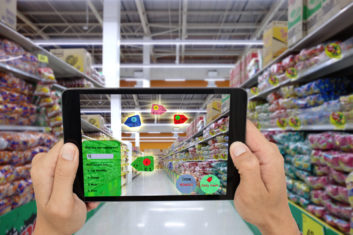 AR has also permeated the domain of broadcast entertainment, being used for example recently on Strictly Come Dancing, where an elephant appeared onscreen alongside dancers Bill Bailey and Oti Mabuse. In another episode of the show, dancers appeared to be on top of a moving train and flying through the air above a city.
AR has also permeated the domain of broadcast entertainment, being used for example recently on Strictly Come Dancing, where an elephant appeared onscreen alongside dancers Bill Bailey and Oti Mabuse. In another episode of the show, dancers appeared to be on top of a moving train and flying through the air above a city.
Analysts at PWC recently forecast that by 2030 XR will boost the global economy by $1.5tn. Pippa Bostock, business and development project manager at Portsmouth University’s Faculty of Creative and Cultural Industries, says that XR has the potential to bring transformative benefits. “From allowing the navy to train people remotely from all over the world to allowing surgeons to train for a procedure from across the country. It’s in its infancy but has incredible potential,” she adds.
Immersive realities
October will see the opening of Portsmouth University’s Centre for Creative and Immersive Extended Reality (CCIXR), which will bring all elements of immersive capture under one roof.
Bostock mentions that she will be installing a number of holovision fans at the centre, which she saw at CES last year. These simple devices consist of four bladed fans with LED lights embedded into them, when the fan spins a 3D image is created. They are already being adopted by retailers looking to create eye-catching signage displays in shops and other places of high footfall.
CCIXR will also have a number of high-powered projectors. While they aren’t used in pure VR or AR applications, projectors are often used in immersive experiences that combine XR technologies. “Look at The War of the Worlds show in London – they use projectors and VR headsets, as a whole it is immersive,” says Bostock.
In Liverpool, London-based company Holovis was drafted in to create The Royal Liver Building 360 experience, which opened in April 2019. Using a mix of AR and projection onto the internal walls of the clock tower, the story of Liverpool since the 1800s is told by blending 270-degree visuals with 5.1 surround sound. “We chose projection as the medium to best deliver the story,” says Alex Kunawicz, Holovis’s experiential creative director.
Elsewhere, fans of deceased musicians such as Whitney Houston and Michael Jackson have flocked to see ‘holograms’ of the stars perform on stage. These aren’t actual holograms but are two-dimensional images reflected by mirrors onto a black background using the 200-year-old Pepper’s Ghost.
In the education and enterprise sectors, Holovis recently collaborated with the University of Exeter on VSimulator, a motion platform simulator designed to allow the study of human interaction with the built environment. On the platform, nine users can be simultaneously immersed in shared experiences using VR headsets, with all the motion and movement data captured by the system for processing and analysis.
The facility can be tailored to meet the testing requirements of sectors including construction, engineering, medical and sports science. For example, it has been used by medical researchers investigating how older people can move safely around certain environments.
Driving interest
Amelia Kallman, futurist, says that the pandemic has been a massive driver of interest in XR from business and that these technologies have been able to demonstrate their value to industries including healthcare, manufacturing, education, design, tourism, consumer goods and marketing. She fears that XR is, however, in danger of failing to deliver on the hype surrounding it.
“The future of the industry relies on its ability to live up to the promises that XR can save companies time and money, accelerate processes, measure engagement, bring people together in unique and memorable ways, and create new revenue streams that don’t only justify costs, but proportionally outweigh them,” she says.
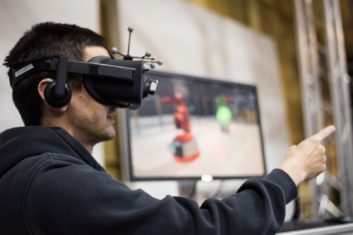 Kallman predicts that two other nascent technologies will help XR to live up to its promise – edge computing (the capturing, processing and analysing of data near where it is created) and 5G telecommunications. “These innovations will provide the practical infrastructure necessary for mass transmission of large data sets at higher speeds, ensuring a seamless immersive experience anywhere at any time, whether it’s through a mobile, laptop or headset,” she explains.
Kallman predicts that two other nascent technologies will help XR to live up to its promise – edge computing (the capturing, processing and analysing of data near where it is created) and 5G telecommunications. “These innovations will provide the practical infrastructure necessary for mass transmission of large data sets at higher speeds, ensuring a seamless immersive experience anywhere at any time, whether it’s through a mobile, laptop or headset,” she explains.
In the meantime, both VR and AR have proved how beneficial they can be to certain sectors. Kallman cites the example of training organisation The Leadership Network, which has moved its masterclasses online using a VR platform, saving clients £1,800 per person on average and reducing the amount of “out of office” time per trainee.
Media masters
Social media has played a role in effortlessly shoehorning AR into our lives. “Gucci partnered with Snapchat for the platform’s first global branded AR shoe try-on lenses”, Kallman says. The AR lens overlays a digital version of up to four pairs of shoes on the feet of someone looking at their mobile device and allows immediate purchasing via the Snapchat app. Snapchat says it is used by 90 per cent of people aged 13 to 24 in the US.
As for the future, Kallman believes the evolution of AR and MR [mixed reality] technologies has the potential to be “quite profound”, fundamentally changing the way we interact with the world.
“The entire world will become real estate for interactive, shoppable digital signage viewed via phones, glasses and, sooner than one may think, contact lenses or implants,” she adds..
Smart visions
Reveley agrees that smart glasses are the next big step, where AR images and signs could appear in our field of vision according to our needs and preferences. For example, step-by-step directions for finding places but also adverts that pop up for a nearby branch of a shop or restaurant, linked to real estate digital signage.
According to Kallman, one of Apple’s patents focuses on the ability of lenses to automatically adjust according to the eyesight of its user. “It suggests that the optical module associated with individual eyes will be able to modify displayed images to correct the user’s vision,” she says.
Kallman concludes that when the pandemic subsides and we begin to return to physical environments, whether it be retail shops or museums or other entertainment facilities, AR activations will play a significant role in our ability to deliver information and engaging experiences.
